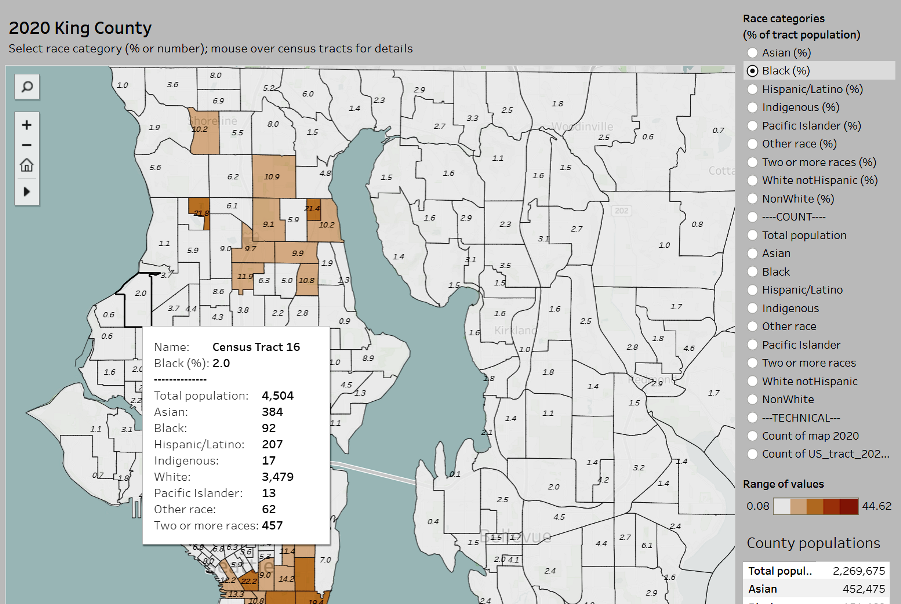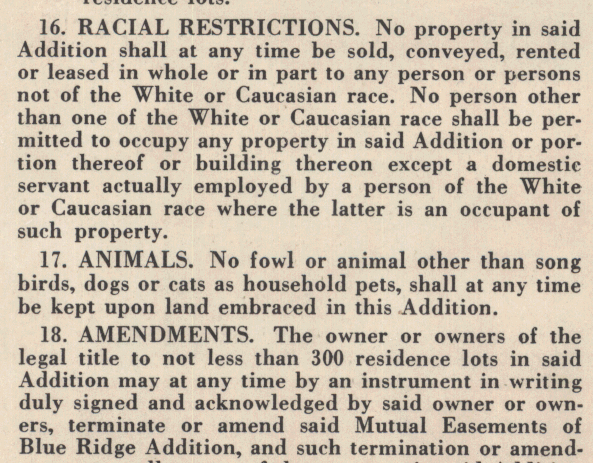William Boeing, the founder of Boeing Aircraft, purchased large tracts of land in what is now Northwest Seattle and Shoreline from Puget Mill Company intending to develop and sell lots and homes, holding title jointly with his wife Bertha. Platted in 1930, Blue Ridge was the first of the Boeing subdivisions, but after logging, grading, and laying out roads and a water system, the Boeings saw their plans to sell properties stall in the economic crisis of the early 1930s. In 1934, they signed a contract with Hugh Russell, an experienced realtor, who took charge of marketing and selling the properties for what was intended to be an expensive and "restricted community" with extraordinary views of Puget Sound and the Olympic Mountains. The Boeings later contracted with Russell to market Innis Arden, Richmond Beach, Richmond Heights and other prime areas on the ridges overlooking the Sound. In each case, the Boeings recorded restrictive covenants designed to prevent anyone who was not white from living in these neighborhoods.
Sales began in earnest in 1938 when the Boeings filed an "Amendment of Mutual Easements" with the King County Recorders Office establishing a set of "Protective Restrictions" to foreover govern the nearly 476 properties in the neighborhood. Number 16 was labeled "Racial Restrictions" and included the following terms:
No property in said addition shall at any time be sold, conveyed, rented, or leased in whole or in part to any person or persons not of the White or Caucasian race. No person other than one of the White or Caucasian race shall be permitted to occupy any property in said addition or portion thereof or building thereon except a domestic servant actually employed by a person of the White or Caucasian race where the latter is an occupant of such property.
These restrictions were made known to prospective buyers in an attractive brochure that the Hugh Russell Realty company used in marketing property in the new "Restricted Residential Community."
Blue Ridge Club, Inc.
in 1941, as more and more homes appeared in the fast growing neighborhood, Hugh Russell, D.R. Drew, and Lucien F. Marion filed Articles of Incorporation with the Washington Secretary of State to create the Blue Ridge Club, Inc. The document included Club By-Laws that would control community recreational properties including beach areas, tennis courts, parks, and a community center. Membership in the Blue Ridge Club followed the properties. Most owners would be eligible to join and use the community facilities. But the By-Laws set out racial rules for membership that were different than the "White or Caucasian race" rule that restricted who might purchase property or live in Blue Ridge.
Article IV, sec.1 specifies that “No Asiatic, Negro or any person born in the Turkish Empire, nor lineal descendant of such person shall be eligible for membership in the Club.”
Why Turkish Empire?
The reference to the "Turkish Empire" is what is unique and puzzling. We have found hundreds of residential restrictions barring Blacks and Asians, a few aimed at Hawaiians, and more than a dozen against Jews. In Clyde Hill, J. Gordon and Mary Schneidler imposed a restriction that banned anyone not of the "Aryan race," a designation that presumably applied to all persons of Eastern and Southern European ancestry as well as nonwhites.
The segregationists who wrote the Blue Ridge Club restriction apparently had something narrower in mind. The term "Turkish Empire" would have referred to the Ottoman Empire that had once ruled the Middle East but had been dismantled at the end of World War I. But census records demonstrate that there were few immigrants from any part of the Middle East living in Seattle in 1940. With one exception. Sephardic Jews from the island of Rhodes, part of the Ottoman Empire, had been settling in Seattle since the early 1900s; not in great numbers, but by 1941 the community was large enough to attract notice.
Attorney resident Doug Dunham, who brought the Club restriction to our attention, contacted us about the Turkish Empire reference wondering who it referred to and at first thought it was addressed to Armenians. We mentioned the possibility that it was directed at Sephardic Jews and he thought that was a real possibility. UW History Professor Devin Naar, an expert on Sephardic history, is inclined to agree. If so, it raises an interesting question. While many segregationist developers banned all Jews, why did the Blue Ridge founders adopt this narrower system of religious bigotry?
Campaign to remove restrictions
When Doug Dunham moved to Blue Ridge in 1983, he was shocked to realize that the neighborhood, like many communities governed by neighborhood associations, had done nothing to remove the offensive racist language from By-Laws and official documents. Elected to the Blue Ridge Club Board of Directors, he spearheaded a community campaign to strike the offensive clause. The By-Laws had been amended in the early 1960’s by simple vote of the Board of Directors to delete the racial restrictions for using the Club facilities, but the racial restrictions in the real estate mutual easements were still in place. In 1989, after personally securing nearly 500 notarized signatures agreeing to the removal of the racial clause, Dunham, with the support of the Blue Ridge Board, filed an amended Blue Ridge Mutual Easements without any racial restrictions.
Lingering story of segregation
Since 1968, it has been illegal to discriminate in the rental or sale of housing on the basis of race. But generations later Blue Ridge residents are overwhelmingly White. As as 2020, the census tract that contains Blue Ridge (numbered tract 16 on this interactive map) counted 92 Black residents in a population of 4,504. People of Asian, Latinx, Indigenous and mixed backgrounds numbered 986, with Whites comprising 76% of the census tract population. This was a big improvement over 1970 when the tract was 99.2% White, but Blue Ridge shares a story with much of north Seattle. Single family neighborhoods north of the ship canal show the strongest lingering effects of the forceful segregation practices -- including deed restrictions and restrictive covenants -- that were commonplace in the middle decades of the twentieth century.
Explore our map of racial change
Below is a screenshot of our interactive map showing the 2020 population of the census tract encompassing Blue Ridge. Click to visit the interactive version which shows population changes for each decade from 1950-2020. Use the filters to show number counts and percentages for various racial groups.

Sources:
David Wilma, "Seattle Neighborhoods: Blue Ridge — Thumbnail History," HistoryLink.org
Bryan Schefke, "William Edward Boeing (1881-1956)" Immigrant Entrepreneurship 1720-Present
Articles of Incorporation for Blue Ridge Club, Inc. (courtesy Doug Dunham)





